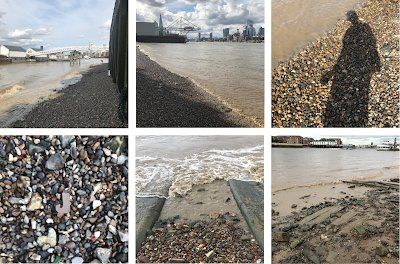I was recently in Bermondsey for a River Thames event and, as mudlarking guide, I was there to share a bit of local history and provide a kind of Show & Tell with the attendees, explaining to them the dos and don'ts of access to the foreshore and what we might hope to find on the surface in this area.
 |
| Bottom left: a little bit of broken cardboard that happened to make the shape of J (for Jane)! |
As I explained to the group, unless you have, like I do, a permit purchased from the Port Of London Authority which allows you to scratch the surface, you can do little more than walk the dog or enjoy the peaceful atmosphere. You cannot dig. Even if you do have a permit (and the PLA are not allocating any new ones at the moment) you can only disturb the very top couple of inches. But, quite frankly, you don't need to dig as it's simply a matter of getting your eye in and, if all you are picking up are broken bits of shell and pottery sherds, that's fine. But please be selective. Many people take bag loads of found items home with them and then don't know what to do with it all. Hence, it ends up in household rubbish and then in landfill which is a shame. Better for it to stay as part of the River Thames. Therefore, I always encourage people who join me for my foreshore forages to choose just three items to take home with them and leave the rest behind to be covered by the next tide. As with all unusual finds, if you do find something that you think might be an artefact of historical interest, simply contact the lovely people at Portable Antiquities Scheme who will advise you.
Here are some little gems that picked up at Bermondsey, some of pieces are tiny, less than 1cm across, and we found them simply sat on the higher drier parts of the beach looking carefully around our legs. All the blue and white crockery was in an area less than 2 metres square. It's not that someone dumped it there, it's because the tide dropped it there being as it was all of similar weight. This is evident on curved stretches as the tide copes with different obstacles and the beach changes from a swathe of sand to small shingles, then a heap of bricks and masonry, then a muddy section and back to shingle again.
The seven fragments top left are single-sided, late Georgian through to twentieth century as are the six little pieces in the top middle pic which are two-sided (the flip side shown top right). And I do love bit of tide-worn glass, or sea glass as some people call it. I don't know what that B stands for (it's probably from a beer bottle) but holding up the fragment to the light made it look like a cola ice lolly, especially against the beach!
I found quite a few bits of intriguing pottery, some glazed on both sides (top left and centre) plus some lovely little pieces of semi-precious stone, marble, flint some of which have holes worn within them or are pleasing shapes shuch as the ling tubular bit of flint and the Shard-shaped triangle which I had meant to hold up against the London skyline to replace the building on the Southbank, but completely forgot to do that!
Bottom left, above, shows a collection of stones with layered rocks and sediments some of which resemble fancy cakes or cuts of meat. As a gauge of size, the largest piece is approx 35mm long. A larger version of the 'roulade' is here to better illustrate the food idea. One of the pieces looks at first like it is glazed, especially as the pattern within the stone resembles a map of Cyprus! And the collection bottom right is simply about colours and textures; a selection of alabaster, coral, brick and stone. I also collected a few fragments of clay pipe (not shown here) which I will soon turn into items of wearable jewellery etc.
Finally, some Health and Safety advice about accessing the foreshore – despite any historical images you might have seen showing people paddling in the Thames or sitting on deckchairs on its beaches, the Thames is not akin to a day out the seaside. If you do venture down there be sure to wear sensible, preferably waterproof, shoes or boots and access only via staircases that are clearly managed and maintained. However, note that these steps can be very slippery due to algae or silt. And on the foreshore, if a surface looks dodgy or slippery then it probably is; don't stand on it or you might sink into soft ground. Be sure to stay close to the access steps because when the tide starts coming in again it will come in fast and you really don't want to get stranded or swept away in the current. And, if you do want to pick anything up, please remember that the water is not clean; wear gloves, use sanitiser.



No comments:
Post a Comment
Please note that comments are vetted by me personally to check for relevant content before they are published, so don't panic when your feedback isn't immediately visible.
If you write anything perceived to be an ad, spam or self promotion, your comment will be deleted and/or marked as spam/blocked.
Thanks, Jane